Starfleet
Created by Commodore Wilkan Targaryen on Sat Dec 10th, 2022 @ 6:02pm
Starfleet
 Logo of Starfleet | |
| Founded: | 2161 (Current Form) 2130 (United Earth) |
| Government: | United Federation of Planets |
| Mission: | Exploration and Defense |
| Headquarters: | Starfleet Headquarters, San Francisco, United Earth |
| Flagship: | U.S.S. Enterprise |
| Motto: | Semper Exploro |
 Emblem of Starfleet | |
History
Starfleet was established by United Earth in or around the 2130s as an Earth-based space exploration organization with the highest authority within the organization being Starfleet Command, located at Starfleet Headquarters in the city of San Francisco on Earth. In less than a decade after its founding, Starfleet had expanded considerably with multiple projects underway to enhance humanity's knowledge of the galaxy. One such operation was the NX Project, which aimed to develop a viable and fast interstellar engine that would allow Earth ships to cross vast distances in a reasonably short amount of time. Despite the protests of the Confederacy of Vulcan, Earth would perfect their Warp Five engine, with Enterprise NX-01, the first Starfleet vessel to carry the engine, launched in 2151.Under the command of Captain Jonathan Archer, Enterprise played a large part in the establishment of Earth as an interstellar power, establishing contact with over 30 different species during its service life and creating the Coalition of Planets between the Andorian Empire, Confederacy of Vulcan, United Earth, and the United Planets of Tellar. Nonetheless, despite their early successes, Starfleet was unprepared for the dangers of the Sphere Builders and their assault upon Earth through the Xindi. Unperturbed, Starfleet ordered Enterprise to investigate while the remainder of Starfleet retained their exploratory focus.
While Enterprise was able to resolve the Xindi crisis, Earth experienced a brief period of xenophobia where not all Humans supported Starfleet's objectives and policies. This would later be exacerbated by the Romulan Star Empire, which launched an attack against Earth and its allies in 2156. When the war ended in 2160, the final preparations were completed for the creation of the United Federation of Planets, with the organization being officially created in 2161.
With the formation of the United Federation of Planets in 2161, Starfleet, MACO, and the deep space and defensive services of the other member worlds were merged under the authority of the Federation. The United Earth Starfleet was chosen to be the administrative body of this new organization, with the mandate to "...seek out new life and new civilizations," and "...go boldly where no one has gone before.". As the Federation began to grow, so did Starfleet with the early organization consisting of vessels adopted from the naval forces of its member species. Before the dawn of the 23rd Century, Starfleet began a massive endeavor to construct its own fleet of ships, using designs melding the diverse technologies of the Federation's members.
Starfleet's exploration and expansion of the Federation would bring the entire organization into conflict with the Klingons in the mid-23rd Century. As the Federation encroached on its borders, a long Klingon warrior named T’Kuvma sought to unify the Klingon Empire against the Federation. While serving as the Federation's official First Contact with the Klingons, the resulting battle and war that came from it devastated the Federation and its worlds, nearly destroying the Federation. As the Federation rebuilt, Starfleet returned to its peaceful exploration of the galaxy with the Constitution Class serving as its frontline exploratory vessel for this golden age.
The 24th Century saw the rapid evolution of Starfleet both in size and capability. With the Klingon Empire having established peaceful relations following the destruction of Praxis and the Romulan Star Empire retreating within their borders, Starfleet and the Federation experienced a rapid proliferation of technologies. These advancements allowed Starfleet to explore deeper into the galaxy, but did not prevent conflicts from arising with the Cardassian Union as they annexed planets near to the Federation. As no clear border existed between the Federation and Cardassians, multiple skirmishes occurred as both governments claimed worlds, leading to the Federation-Cardassian War of 2347–2366.
Despite the threat of the Cardassians, nothing was as horrific for Starfleet and the Federation as first contact with the Borg Collective in 2365. The Starship Enterprise was propelled by the being known as Q to the Delta Quadrant, where it encountered a lone Borg vessel on patrol in system J-25. During the brief contact the Enterprise, Starfleet's most advanced vessel, was quickly outmatched and only survived due to the manipulation of Q. Less than a year later, the Borg invaded Federation territory. Led by Locutus, an assimilated Captain Picard, the Borg engaged a Starfleet Task Force of 40 vessels at Wolf 359, destroying 39 of the vessels and killing nearly 11,000 Starfleet Officers before finally being defeated by the Enterprise.
While contact with the Borg had been devastating for the Federation and Starfleet, it led to the passing of the Perimeter Defense Directive by the Federation Council. While Starfleet's forces had been refitted to incorporate every technological advantage available, most of the fleet was aging aside from a few newer designs (including the Galaxy Class explorer). This Directive ordered Starfleet to revolutionize its navy, leading to a renaissance in ship design and construction. These advancements were especially welcome with the discovery of the Bajoran Wormhole, the first stable wormhole known to the Federation, and first contact with the Dominion.
After a brief, renewed conflict with the Borg and Klingon Empires, the Federation learned that the Cardassian Union had agreed to merge with the Dominion. With their newfound allies, the Cardassians launched an invasion of Federation territory to gain control over the Bajoran Wormhole from the Federation. Initially succeeding in their efforts, the Dominion War affected every major power in the Alpha and Beta Quadrant with Starfleet trapped in the middle. After several devastating battles, Starfleet was able to turn the tide and gain the upper hand in the conflict. When the Alpha Quadrant Alliance gained ground, the Dominion allied with the Breen, who launched multiple wide scale attacks on Federation territory and destroyed the Starfleet Ninth Fleet at AR-558. If not for the discovery of a cure for the morphogenic virus killing the Founders, leaders of the Dominion, it was highly likely that the Federation and Starfleet would have been destroyed. During the Battle of Cardassia, Starfleet agreed to transfer the cure to the Dominion in exchange for their cease fire.
While it was hoped that Starfleet could return to peaceful exploration of the galaxy, Starfleet would soon find itself facing multiple catastrophes following the Dominion War. While the crew of the Starship Voyager returned to the Alpha Quadrant, destroying the Borg’s Transwarp Network in the process, it was soon learned that the Hobus Star in the Romulan Star Empire was destabilizing and would destroy multiple worlds in the process, including Romulus and Remus themselves. The Federation Council agreed to launch a recovery mission under the leadership of newly promoted Admiral Jean-Luc Picard, transferring extensive resources to the effort of evacuating the impacted worlds.
Nonetheless, Starfleet would find itself nearly destroyed for its kindness. The Federation and Starfleet were infiltrated by members of a Romulan secret cabal known as the Zhat Vash which led to the Attack on Mars in 2385. The Utopia Planitia Shipyards at Mars were attacked and destroyed by reprogrammed synthetic workers, leading the Federation Council to order the total ban on all forms of artificial life in the Federation. With Starfleet resources already stretched extremely thin by the Romulan evacuation, the damaged fleets from the living construct attack in the Battle of Gamma Serpentis, and the Attack on Mars, Starfleet was restructured by the Federation Council with approval of the Federation President into a fully functional military organization. Starfleet pulled out of the Romulan evacuation and ceased all exploration in favor of planetary defense, leading many Starfleet Officers to resign in protest. Despite the ban on synthetics eventually being repealed after the truth about the Attack on Mars was revealed, Starfleet would never be the same.
While Starfleet was a more defensive organization in the late 24th Century, that did not stop technological advancement as Starfleet gained access to former Romulan assets. Through the investigation of the Borg Cube Artifact in association with the Romulan Free State, Starfleet was able to reverse engineer several Borg technologies for the first time. None of these advancements would prepare Starfleet for the Battle of Frontier Day. Taking place in 2401 during the 250th Frontier Day, 339 starships participated in a demonstration of Fleet Formation Mode at Earth when remnants of the Borg Collective used the reverse engineered technology to conscript the Starfleet vessels into the Borg fleet. Further, using modified Transporter code, the Borg were able to assimilate any Starfleet Officer younger than 25 years of age, turning them against their crewmates. Admiral Jean-Luc Picard and his crew, using the museum ship U.S.S. Enterprise-D, were able to defeat the Borg ship once and for all, saving the Federation and Starfleet.
The new, militarized Starfleet found itself embroiled in several high-profile conflicts in the early 25th Century. The Klingon Empire invoked an ancient claim on the Hromi Cluster and later the Archanis Sector, demanding that all Federation citizens must leave immediately. After the Klingons invaded Korvat, Starfleet blockaded the region and the Klingons retaliated by invading the Archanis Sector. By 2409 the Federation and Starfleet would find themselves fighting wars on several fronts as the Romulan Free State entered the conflict and attempted an invasion of Vulcan. Starfleet forces, led by the Enterprise, were able to repel the Romulans; however, evidence was uncovered that renegade Changelings had adapted once more and were now allied with Species 8472 to destroy the Federation. Influencing the events of the Federation-Klingon War, the Changelings and Species 8472 launched an attack on both Earth and Qo'noS, leading the Federation and the Klingon Empire to sign the Third Khitomer Accords, declaring an armistice that ended hostilities between the two powers.
With the emergence of a new peace in the Alpha and Beta Quadrants, the Federation Council authorized Starfleet to launch exploratory missions once more and returned to an external exploratory focus not seen since the 23rd Century. During this exploration period, it was discovered that many of Starfleet's designs had stagnated through the years of experience with familiar races and, often, Starfleet forces were outclassed by opponents that were encountered. This led Starfleet Command to assign increased resources to new technological development and the continued construction of smaller, specialized starships.
While this age of discovery benefitted the Federation and Starfleet, storm clouds soon gathered as the Vaadwaur Supremacy, long thought isolated to the Delta Quadrant, launched an attack upon the homeworlds of the Klingon Empire, Romulan Republic, and the United Federation of Planets. Outclassed by the Vaadwaur war machine, evidence was uncovered that the Vaadwaur had located and were using an ancient Preserver relic known as the Foundry to supplement their forces. All Starfleet forces were recalled to Federation space to defend the region from attack, but Starfleet remained heavily outnumbered by the Supremacy. In time a combined Starfleet Task Force was able to defeat the Vaadwaur menace.
With the Vaadwaur threat defeated, the United Federation of Planets and Starfleet have entered into a new era of peace. Exploration missions of the galaxy have resumed, with Starfleet Command authorizing a new deep space exploratory assignment code named: Longshot.
Organization
Starfleet falls under the administration of the President of the United Federation of Planets, who serves as the supreme authority for all Federation forces; however, the Federation Council, the Federation's legislature, had control Starfleet's resources and operations. Reporting directly to the President, the Commander-in-Chief was responsible for directing Starfleet's day-to-day operations, overseeing Starfleet Command, and granting commissions to officers; however, the President could choose to oversee this responsibility directly.All of Starfleet's operations are managed through a set of regulations, known as Starfleet's General Orders and Regulations. These rules governed all aspects of Starfleet service and covered a variety of situations that Starfleet personnel may encounter during their assignments, from protocol to situations of first contact with unknown species. Perhaps the best known and most important regulation was Starfleet's General Order 1, also known as the Prime Directive, which was built upon the philosophical concept that Starfleet personnel should refrain from interfering in the natural, unassisted, development of societies, even if such interference was well-intentioned.
Starfleet Command
Based in San Francisco, United Earth, Starfleet Command is the operating authority for the Federation Starfleet and handles the fleet's day-to-day operations. Headed by the Commander in Chief of Starfleet and answering directly to the Federation President, Starfleet Command assigns missions to its officers, supervised the Sector Commands, and oversees the constituent services of Starfleet. The organization's primary management center was located at Starfleet Headquarters in San Francisco, Earth; however, secondary command centers were located throughout the Federation on many worlds.
Branches and Agencies
There were a number of branches and agencies that made up the organizational substructure of Starfleet Command in the administration of the service. These include:| Starfleet Academy was a department within Starfleet with the purpose of educating and training individuals for service in Starfleet. | |
| The Starfleet Corps of Engineers is the Starfleet agency tasked with solving specialized engineering problems. One of the oldest agencies within Starfleet, with its origins dating back to the United Earth, the Corps of Engineers had a galaxy-wide reputation as the undisputed masters of technological adaptation and modification. | |
| The Starfleet Diplomatic Corps was a branch of Starfleet that negotiated with other powers in association with the Federation Diplomatic Corps. | |
| Starfleet Intelligence was a branch of Starfleet responsible for gathering and analyzing information concerning neighboring powers in the galaxy, and for carrying out covert investigations regarding possible threats to the Federation. | |
| The Judge Advocate General's Office was the division of Starfleet Command that administered legal affairs. | |
| Starfleet Medical is the Starfleet branch dedicated to the medical needs of its personnel and biomedical research, overseeing all Starfleet medical personnel and facilities. | |
| Second only to Starfleet Command itself, Starfleet Operations is the authority for many critical facets of Starfleet's activities, including the management of Starfleet's resources. | |
| Starfleet Research and Development was the agency responsible for researching, developing, and testing new technologies. | |
| The largest agency in Starfleet, Starfleet Sciences is the agency responsible for scientific research and development. | |
| Starfleet Security is the Starfleet division responsible for safeguarding the Federation from threats, conducting criminal investigations and a variety of other security duties. | |
| Starfleet Tactical is the Starfleet division responsible for the designing, planning, and implementation of both offensive weaponry and defensive measures within Starfleet. |
Quadrant and Sector Commands
Quadrant Commands oversee Starfleet operations within a specific quadrant of the galaxy, while Sector Commands oversee specific sectors of Federation space. Quadrant Commanders reported directly to the Chief of Starfleet Operations, while each Sector Commander reported to the Quadrant Commander at Starfleet Command, and Commanding Officers of service vessels operating within each of these sectors reported to Sector Command. Starbases and outposts located in the sector likewise fell under the purview of the Sector Command.
Key Starfleet Personnel
 Fleet Admiral Dazad Targaryen El-Aurian/Human Male |
 Admiral Harrison Andrews Human Male |
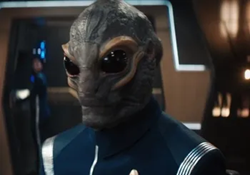 Admiral Kretk Saurian Male |
 Vice Admiral M'Rrasi Caitian Female |
 Vice Admiral Pashao zh'Shalrel Andorian Zhen (Female) |
 Vice Admiral Astran Deix Ligonian Male |
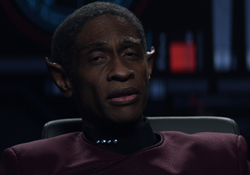 Vice Admiral Tuvok Vulcan Male |
 Vice Admiral Mia Vescovi Human Female |
 Vice Admiral Croam Bav Khock Tellarite Male |
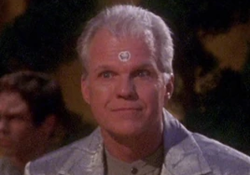 Rear Admiral Rarde Damaautte Risian Male |
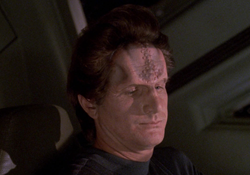 Rear Admiral Cijorl Iyaaran Male |
 Rear Admiral I'si Penii Idanian Female |
 Rear Admiral Ada DeSoto, MD Human Female |
 Rear Admiral Lezu Tigan Trill Female |
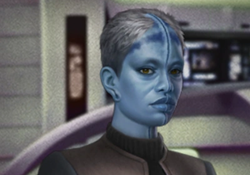 Rear Admiral Mylea Ernoras Bolian Female |
 Rear Admiral Eshor Kol Bajoran Male |
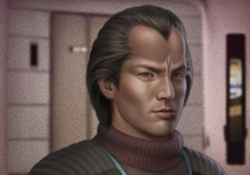 Rear Admiral Snrlonchohr Ktarian Male |
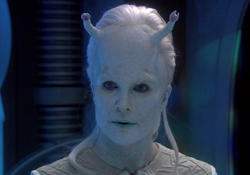 Commodore Sythi sh'Ijhossaa Aenar Shen (Female) |
 Commodore Loatha Targaryen Deltan/El-Aurian/Human Female |
 Commodore Zseeq Deltan Male |
 Commodore Rafael Arriaga Human Male |
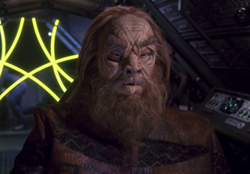 Commodore Xersh Jav Teggh Tellarite Male |
 Commodore T'Paang Vulcan Female |
Emblem
Starfleet's insignia is an asymmetrical, arrowhead-shaped pennant that is utilized on Starfleet's communicators, vessels and other ware. Throughout Starfleet's history the insignia has been configured to represent the wearer's division, with a star signifying command, a stylized spiral representing operations, and a circle with longitudinal lines indicating science. Additionally, the emblem has also incorporated a wearer's rank at various periods in Starfleet history.
Operational Forces
Primarily consisting of exploratory and military spacecraft, the operational forces were the main component of Starfleet and were comprised of enlisted personnel, responsible for executing orders, and commissioned officers, charged with issuing orders. While Starfleet often operated ships individually on solo missions, ships were also organized into larger fleets, most often during times of war. Fleets usually consisted of several hundred ships and were typically commanded by a flag officer, typically headquarters at a Starbase. Starfleet currently has 27 active fleets which are divided between standing fleets, which are assigned to a particular region, and mobile fleets, which are routinely redeployed to new frontiers. These fleets are further grouped under Fleet Forces Command depending upon the Quadrant in which they operate.
Starbases
The size, complexity, and intergalactic presence of Starfleet requires that the organization employ a sizable number of fixed installations to support its daily operations. Starbases were large facilities that were set aside for resupply of Starfleet vessels and the relaxation of vessel crews. Most Federation Starbases were commanded by Starfleet officers, often a flag officer; however, some were under civilian authority. Starfleet's Starbases are all located within the territory of the United Federation of Planets itself; however, a significant number of facilities, known as Deep Space Stations, operate within territories managed by affiliated governments. Often, Starbases are responsible for some degree of fleet and sector command coordination as well as some diplomatic services.Despite their purposes the exact layout and appointment of a Starbase varied, but all bases consisted of some combination of space stations, drydocks, and/or ground installations. The majority of Starbases were appointed to perform starship maintenance, repair, and refitting functions, while some also incorporated facilities for the design and construction of vessels. Starbases also provide a location for the rest and relaxation of starship personnel, offering impressive shore leave facilities to visiting vessels as well as sophisticated medical facilities beyond those available while on patrol.
Presently, Starfleet employs three classifications for Starbases within its system.
- Outpost: A small, fixed installation, an Outpost is a lightly armed and shielded installation that is constructed in an area where a permanent facility is needed, but a full combat-ready station is not.
- Starport: Larger than an Outpost, a Starfleet Starport is a moderately armed and defended station that are used to establish control points over a region.
- Starbase: The largest fixed installation built by Starfleet, Starbases are heavily armed, heavily protected, and extremely dangerous opponents that provide major staging areas from which to deploy starships.
Noteworthy Starbases
 Ananke Alpha Outpost |
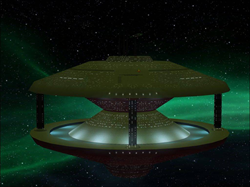 Deep Space 5 Starbase |
 Deep Space 9 Starbase |
 Deep Space Station K-7 Starport |
 Earth Spacedock (Ret.) Starbase |
 Jupiter Station Outpost |
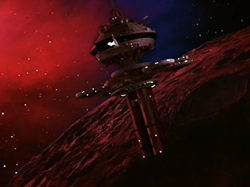 Regula I Outpost |
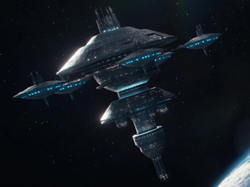 Sol Station Starbase |
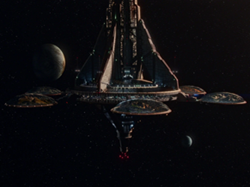 Starbase 1 Starbase |
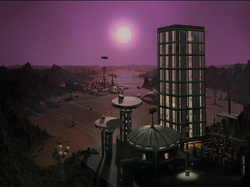 Starbase 11 Starport |
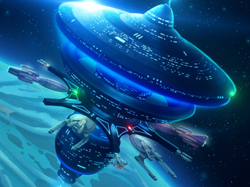 Starbase 25 Starbase |
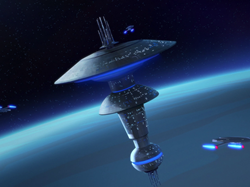 Starbase 74 Starbase |
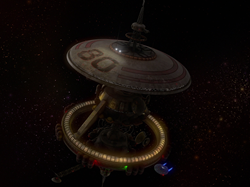 Starbase 80 Starport |
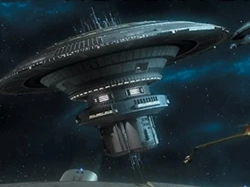 Starbase 364 Starport |
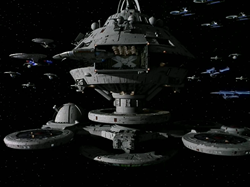 Starbase 375 Starbase |
Shipyards
An extension of Starbases, Shipyards are a collection of orbital drydock facilities that are used in the construction of vessels.Starships
The backbone of Starfleet's operations were its fleet of starships. These warp-capable vessels helped to carry out the service's mandates: exploration, the defense of the Federation, and support of the Federation's worlds, colonies and outposts.As of early 2439, Starfleet Logistics had identified a need for a minimum of 57,000 vessels to meet its commitments, but could only afford resource wise to field only 42,000 active ships. Throughout its history, Starfleet vessels usually operated independently, and it was common for a single ship to be the only one in range of an unfolding crisis - whether near the Federation core or on its frontier. In large-scale conflicts or as a response to an impending threat, Starfleet would, however, often organize its ships in battle groups, task forces and entire fleets.
Federation Starfleet vessels are well–rounded starships that are designed for a variety of mission profiles and assignments. Well-constructed vehicles, Starfleet vessels feature Warp Drives to allow for faster-than-light travel and to generate power for the ship's systems and operations. With exploration being the priority for Starfleet vessels, each ship incorporates enhanced scientific systems - including advanced sensor suites - for examining the mysteries of the galaxy. While they are capable exploration craft, Starfleet vessels also have been equipped with enhanced defensive systems, making even the smallest of Federation starship a dangerous opponent.
Starfleet vessels traditionally come in three versions. While there are is a standard design for each category, Heavy and Light subclasses also exist within each classification. Heavy vessels are more heavily armed and protected than other vessels of the type. While they are designed to inflict, and take, damage, Heavy vessels often must sacrifice their speed, maneuverability, or scientific capabilities to compensate for the additional tactical systems. Light vessels, however, are not as well armed or protected as standard vessels of a type as they incorporate more sophisticated peripheral systems and are intended for specific mission profiles.
Explorers
Explorers have served prominently in Starfleet since its inception and are among the largest, most powerful, most versatile ships in the fleet. Primarily built for exploration purposes, Starfleet's Explorers maintain similar design lineages and incorporate a large, typically saucer shaped primary hull, cylindrical engineering hull, and engine nacelle with a pylon structure. Due to the variety of missions they can undertake, Explorers are highly adaptable and maintain a variety of equipment and system to ensure the safety of the ship and crew during their multiyear missions, which often are far from Federation space. As their missions are oriented toward peaceful exploration Starfleet's Explorer classes are equipped with the most state of the art sensory and scientific equipment available to the Federation; however, as they often encounter threatening situations, they are also Starfleet’s most heavily armed vessels.
 Commonwealth Class Heavy Explorer |
 Odyssey Class Heavy Explorer |
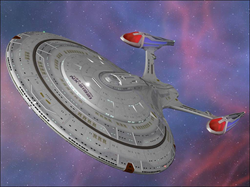 Century Class Explorer |
 Ross Class Explorer |
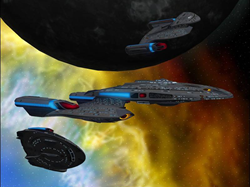 Galaxy III Class Light Explorer |
 Sagan Class Light Explorer |
Cruiser
Smaller than Explorers, Cruisers are the backbone of Starfleet. Cruisers are mid-size, multifunction vessels, that are able to perform a variety of duties thanks to their versatility. Often, these ships are assigned to broad mission responsibilities from exploration, to interdiction, to tactical assignments. As they can maintain a wide variety of general or specialized mission profiles, Cruisers are plentiful within Starfleet as they are easier and less expensive to produce than larger exploratory craft.Often, Heavy Cruisers serve as the flagship for Starfleet Flag Officers and Light Cruisers fulfill varied duties, including supporting Explorers and larger Cruisers in battle, patrol, and diplomatic. While Cruisers come in the traditional Heavy, Standard, and Light classifications, Exploratory Cruisers have been fielded by Starfleet since the early days of the 24th Century. Exploratory Cruisers are a lighter version of an Explorer, and they are and are able to perform many of the same duties as their larger cousins. Battle Cruisers have been designed to incorporate the tactical capabilities of an explorer within the cruiser platform. Fast Cruisers sacrifice some scientific and tactical performance for speed.
 Inquiry Class Battle Cruiser |
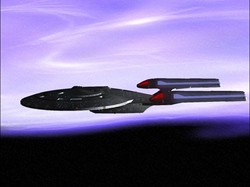 Pandora Class Battle Cruiser |
 Constitution III Class Exploratory Cruiser |
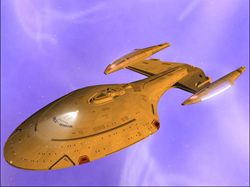 Intrepid II Class Exploratory Cruiser |
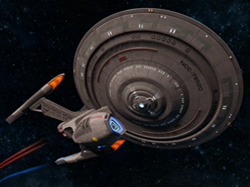 Duderstadt Class Fast Cruiser |
 Korelath Class Fast Cruiser |
 Excelsior II Class Heavy Cruiser |
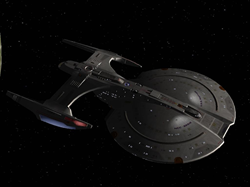 Leonidas Class Heavy Cruiser |
 Sutherland Class Cruiser |
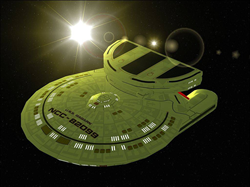 T'Kumbra Class Cruiser |
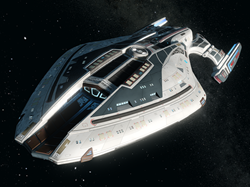 Pathfinder Class Light Cruiser |
 Phinda Class Light Cruiser |
Escort
In general, Escorts are the most overtly “military” vessels constructed by Starfleet and are assigned to perform escort, patrol, and rapid response missions. Escorts are medium to small ships that incorporate the latest technological developments available, with a particular focus on tactical systems, shields, and sensors. Due to the Escort’s tactical orientation, they are heavily armed vessels with incredible speed with sufficient offensive power to deter many threats.
 Alita Class Heavy Escort |
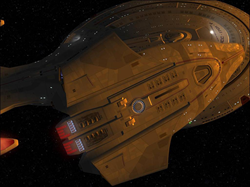 Valiant Class Heavy Escort |
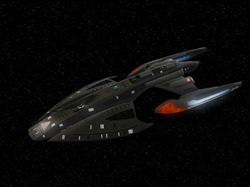 Acquiescence Class Escort |
 Reliant Class Escort |
 Edison Class Light Escort |
 Sentinel Class Light Escort |
Scout
Briefly reclassified as Frigates due to their diminished importance in the early 24th Sentury, Scouts returned to prominence following the Dominion War. Starfleet Scouts, with their small bodies and large warp nacelles, are adept at stellar cartography missions, light exploration, system surveillance and reconnaissance, and related mission profiles. While they are lightly armed, Scouts often perform the role of reconnaissance ship due to their small size and limited sensor profile, running observation missions into enemy territory and returning with valuable information.
 Gagarin Class Heavy Scout |
 Khyzhon Class Heavy Scout |
 LaFayette Class Scout |
 Gol Class Scout |
Auxiliary
Auxiliary vessels are Starfleet ships that perform secondary assignments on behalf of the Federation. Highly specialized vessels, Auxiliary ships complete vital, if somewhat unglamorous, missions in support of the Federation and Starfleet. Multiple types of vessels serve in Auxiliary roles within Starfleet performing a number of missions deemed as "low profile." Without these support ships, Starfleet could not function for long as it is estimated for every Explorer there are three Auxiliary vessels supporting it behind the scenes.
 Lamarr Class Research |
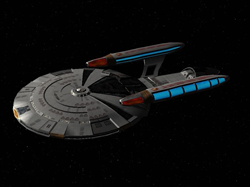 Voshev Class Research |
 Echelon Class Surveyor |
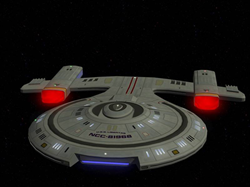 Libertas Class Surveyor |
Personnel
Starfleet has over 800,000,000 personnel as of 2439, with approximately 10% of which serving in ready reserve should they be needed to assist with a calamity. Of Starfleet's active-duty personnel, more than 80% are enlisted personnel and around 15% percent are commissioned officers with the remaining serving as Cadets or Trainees at one of Starfleet's multiple academies.Starfleet has historically been a diverse organization since its inception as part of United Earth and consists of personnel originating from long standing Federation members, recent additions, and even some of the Federation's allies. Starfleet has even accepted individuals from former adversaries, including Klingons, Romulans, or liberated Borg drones. Previously, aliens from foreign governments were required to rescind their membership with their homeworld upon joining Starfleet; however, following Frontier Day 2401, a specialized dual-citizenship program allowing them to maintain citizenship with their originating, non-Federation world was implemented due to personnel shortages.
Commissioned Officers
Starfleet's Commissioned Officers function as the directors of the organization's operations at all levels. The most senior officers were known as flag officers and were considered to be at the highest levels of command in Starfleet and were often in charge of entire departments or important installations. Officers below flag rank typically served in field command positions, such as commanding officers and as senior staff within Starfleet's installations. Commonly, Commanding Officers usually hold the rank of Captain, but Officers can be given their own command as early as a Lieutenant Commander.Graduates of Starfleet Academy were commissioned to the rank of Ensign, the most junior officer rank, and were promoted to higher ranks throughout their time in the service. All Starfleet officers, during their Academy training period, would choose whether they would serve as a line officer or as a staff corps officer. A line officer is an officer that would be eligible for command of operational, scientific, tactical or combat units during their service. Conversely, staff corps officers are specialists in career fields that are professions unto themselves, such as physicians, lawyers, civil engineers, chaplains, and supply specialists.
Commissioned Officer Ranks
O-11  |
O-10  |
O-09  |
O-08  |
O-07  |
|
O-06  |
O-05  |
Commander O-04  |
O-03  |
(Junior Grade) O-02  |
O-01  |
Warrant Officers
Warrant and Chief Warrant Officer ranks are held by technical specialists who direct specific activities essential to the proper operation of a Starfleet intallation, which also require commissioned officer authority. Warrant Officers perform duties that are directly related to their previous enlisted service and specialized training, allowing Starfleet to capitalize on the experience of Warrant officers without having to frequently transition them to other duty assignments for advancement. Currently, most Starfleet Warrant Officers are pooled from the Chief Petty Officer grades and must have a minimum 14 years in service.Warrant Officer Ranks
Warrant Officer W-04  |
Warrant Officer W-03  |
Warrant Officer W-02  |
Officer W-01  |
Enlisted Personnel
Enlisted personnel serve under the direction of the Commissioned Officers, serving aboard Starfleet vessels or other installations. Graduates of Technical Academies, enlisted personnel received basic training for whatever position they served in. Personnel in the lowest rates are considered to be in apprenticeships while Petty Officers perform not only the duties of their specific career field but also serve as leaders to junior enlisted personnel and are distinguished as non-commissioned officers was used.While they do have a defined rank structure, it was also common for enlisted Starfleet personnel to receive the generic title of "Crewman", while also substituting the terms "Specialist" and "Technician." It was also possible for an enlisted Starfleet member to be appointed as a department head, at which time they were given the same authority as a fully commissioned officer, including staffs of both officers and enlisted personnel placed under their command.
Enlisted Ranks
Petty Officer E-09  |
Petty Officer E-08  |
Petty Officer E-07  |
First Class E-06  |
Second Class E-05  |
Third Class E-04  |
First Class E-03  |
Second Class E-02  |
Third Class E-01  |
Cadet
Cadets are full-time college students who are training to become a Commissioned Officer within Starfleet. Students at Starfleet Academy are appointed as midshipmen by the President of the United Federation of Planets without Federation Council confirmation. While there are multiple Starfleet Academy Annexes throughout the Federation, sponsorship from a member of the Federation Council or a Starfleet Commanding Officer is required to receive an appointment at Starfleet Academy, but a nomination does not guarantee an appointment.Cadets assigned to any Starfleet Academy campus study a core curriculum of Engineering, Humanities, and Sciences courses and participate in a required "summer cruise" with an active vessel after their freshman (plebe) and junior academic years. Upon graduation, midshipmen are commissioned as Ensigns.
Cadet Ranks
C-04  |
C-03  |
C-02  |
C-01  |
Career Progression
Advancement within Starfleet was at the discretion of the crewmember, based on their own personal motivations, career plans, and future goals with the member able to set their own pace. Members would advance by requesting certain assignments in their particular field of interest, with some assignments having long waiting lists for those wishing to serve as certain promotions and assignments were considered highly prestigious and competitive.Promotions were based upon the availability of open positions, with personnel being either appointed to the new role or applying for the opening. Depending on the situation, a member could refuse promotion if they felt that promotion would be less beneficial to their careers, or they could voluntarily accept a grade reduction, such as when an Admiral voluntarily reduced in rank to Captain to command a starship. Starfleet members who committed serious errors or infractions while on duty could be reprimanded, and oftentimes this would prevent advancement into higher postings or promotion to senior ranks.
Uniform
Starfleet Uniforms are worn by individuals serving in the Federation Starfleet. Starfleet Uniform Code currently includes styles for dress uniforms, daily service uniforms, and working uniforms, which have varied throughout Starfleet's history. Designed for comfort and durability in the most extreme environments, Starfleet uniforms facilitate the wearers' needs as both scientists and researchers, as well honoring Starfleet's military role. All personnel are expected to abide by the Starfleet Uniform Code, though special exceptions can be made to honor aspects of an individual's cultural heritage.While the color scheme had varied over time, Starfleet uniforms are classified by color with the current colors in practice:
- Command: The Command Division is responsible for the administration of starships, starbases, and space stations. These personnel are distinguished by red coloration.
- Operations: The Operations Division is the backbone of Starfleet and incorporates the engineering, operations, and security departments. This group is responsible for technological innovation and for maintaining and defending the Federation and typically wear uniforms with gold coloration.
- Science: The Sciences Division is the heart of Starfleet and comprises members of the exploratory, medical, and mental health departments within the fleet. Science personnel are identified by uniforms with teal coloration.
- Service: The Service Division fulfills all support roles within Starfleet and are identified by uniforms with silver coloration.
Service Dress Uniform
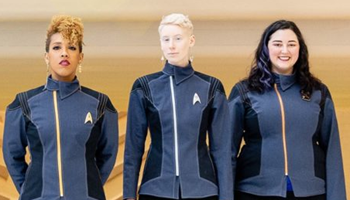 Service Dress Uniforms are worn for official ceremonies such as changes of command, reporting to a command, retirements, commissionings and decommissionings, funerals, weddings, or when otherwise appropriate. At the discretion of the Commanding Officer or assigned Flag Officer personnel may wear awards with their Dress Uniform. Under current guidance, full-size medals are to be worn below the Communicator Badge on the wearer's left breast while ribbons are worn below medals for decorations without corresponding medals.
Service Dress Uniforms are worn for official ceremonies such as changes of command, reporting to a command, retirements, commissionings and decommissionings, funerals, weddings, or when otherwise appropriate. At the discretion of the Commanding Officer or assigned Flag Officer personnel may wear awards with their Dress Uniform. Under current guidance, full-size medals are to be worn below the Communicator Badge on the wearer's left breast while ribbons are worn below medals for decorations without corresponding medals.Service Dress Uniforms are commonly elaborate, designed to be worn during formal occasions of prestige and state, and the design of the current generation of Service Dress Uniform doesn't disappoint. The Service Dress Uniform is based upon the Starfleet uniform of the early 23rd Century and features a Federation blue jacket and utilizes the same Combadge as its counterpart uniforms, with the rank of the wearer being depicted by bars behind a Starfleet delta. By default the Service Dress Uniform came with pants, but female crew members could choose wear the Dress Uniform with a miniskirt over matching high cut shorts, worn with black hose and boots.
The jacket of the Service Dress Uniform incorporates a split cowl collar with a division-colored zipper closure running slightly diagonally from the center line of the jacket. Unlike other uniforms, the departmental colors on the Starfleet Dress Uniform are not as predominantly displayed and use four accent colors representing the different departments. As in the early 23rd Century, Command is signified by gold, Sciences by silver, Operations by copper, and services by black. The flanks of the jacket also feature distinctive navy blue patterns to offset the Federation blue that predominates the tunic.
Service Uniform
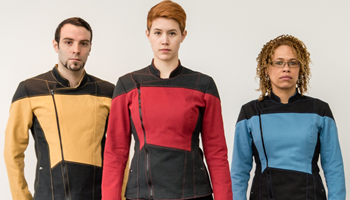 Service Uniforms are the daily wear uniforms utilized by Starfleet personnel and are more casual as they are designed to be worn in an everyday context. Under current uniform guidance, Service Uniforms are to be utilized by personnel in positions that interact with the public, at Starfleet bases and related outposts, and during watch situations. Starfleet authorizes skirts to be worn with service uniforms as warranted at the Captain's discretion.
Service Uniforms are the daily wear uniforms utilized by Starfleet personnel and are more casual as they are designed to be worn in an everyday context. Under current uniform guidance, Service Uniforms are to be utilized by personnel in positions that interact with the public, at Starfleet bases and related outposts, and during watch situations. Starfleet authorizes skirts to be worn with service uniforms as warranted at the Captain's discretion.Introduced in 2439, the Service Uniform utilized by Starfleet is highly reminiscent of the Service Dress Uniform introduced in the 2360s. The uniform jacket includes the distinctive, two-tone style common in the mid-24th Century with the departmental color also being displayed on the shoulders through specialized piping amidst the black material. The jacket incorporates a double-breasted flap running over the right side that is outlined by a black braid that runs the entire length of the jacket closure. The Service Uniform could be worn with trousers or optional skirt for women, depending upon their preference.
While the design harkens back to the golden age of exploration of the mid-24th Century, the Service Uniform incorporates a standard issue Combadge that is worn on the left breast. Featuring a metallic Starfleet insignia that contains the communications equipment, rank bars were built into the back of the badge, with the reverse carrying the wearer's name and serial number for quick identification.
Working Uniform
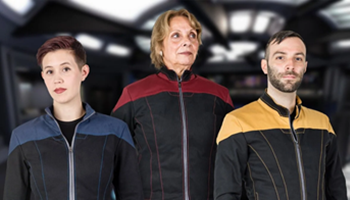 The Starfleet Working Uniforms are durable and utilitarian uniforms that are designed for use in battle and environments where other more formal clothing would be impracticable and might get unduly damaged or dirtied. Unlike other uniforms, the Starfleet Working Uniform only permits the user to wear trousers at this time for safety.
The Starfleet Working Uniforms are durable and utilitarian uniforms that are designed for use in battle and environments where other more formal clothing would be impracticable and might get unduly damaged or dirtied. Unlike other uniforms, the Starfleet Working Uniform only permits the user to wear trousers at this time for safety.The Starfleet Working Uniform is a utility uniform made of heavy-duty fabric that reduces the possibility of snags and tears from sharp objects while protecting the wearer. The uniform was a loose-fitting two-tone jumpsuit that was primarily black with the division color on the shoulders and in piping that ran through the black portions of the jacket, this with coloration was chosen as it helps the user to better hide wear and stains while on duty. The material used in the fabric also offers some resistance to flame, should the wearer encounter fire.
Similar to the uniform introduced in the 2390s, the Starfleet Working Uniform features small Starfleet deltas have been placed into the shoulder fabric amidst the divisional color. Typically, the uniform was worn with an open collar over a black crewneck undershirt with a pair of black trousers. As a utility garment the design features several inner pockets within the jacket and in the trousers for the storage of tools and other equipment. While previous generations of Starfleet Uniform used pips on the collar to depict rank, the current generation of uniform uses a Combadge featuring bars behind a Starfleet delta to identify rank. Black safety boots are included as standard for all personnel wearing the Starfleet Working Uniform.
Categories: No categories found